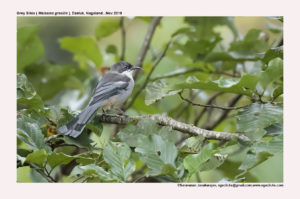
Grey Sibia Malacias gracilis
Etymology:
- Malacias : Greek word for Softness
- Gracilis : Latin word for slender, elegent, slim
Vernacular Names: Naga: Titi
Distribution in India: Resident of Hill of North East India .
Description: Size of 22·5–24·5 cm; wt. of 34–42 g. It is a slender, long-tailed brown and grey bird with white underparts and grey patches in wings and tail. The crown and head side ,lores, cheek and ear-coverts are brownish-black, shading on neck side and upperparts to brown-tinged dark grey, and to pale grey on uppertail-coverts. The tail has grey central feathers and broad blackish subterminal band, outer feathers increasingly blackish but with broad grey tips. The upperwing is black, greater coverts white basally, distal outer edges of outer primaries are pale grey, basal fringes of inner primaries are glossy blue-black, and tertials are pale grey with blackish edges. The chin and submoustachial area to underparts are white, with pale grey flanks, slight buffy wash across breast and on lower underparts. The iris is red to brown; bill is black; legs are dark brown to black. Both the sexes are similar. The juvenile has duller forecrown and crown and browner-tinged than adult, nape to uppertail-coverts and scapulars are paler and browner, body is paler overall.
Habitat: It is found in broadleaf evergreen and deciduous forest, including oak and rhododendron forest, sometimes pine and mixed forests, degraded and secondary forest with scattered tall trees. It is found from 900m to 2800 m.
Food habits: It eats Insects, berries and small fruits. It visits tree blossoms, including those of silk-cotton trees in search of insects and nectar. It forages in canopy and among moss-covered trunks and epiphytes, occasionally descending to bushes and undergrowth.
Breeding habits: They breed in Apr–Aug. The nest is built by both sexes. The nest is a deep, firm, neatly woven cup, made of grasses, moss, roots, leaves, fibres and green pine needles, plastered with green moss and cobweb, lined with grasses, grass seed stems, rootlets and rhizomorphs, placed above ground in crown of tree, outer branches of rhododendron or pine tree or top fork of sapling. They lay a clutch of 2–4 eggs.